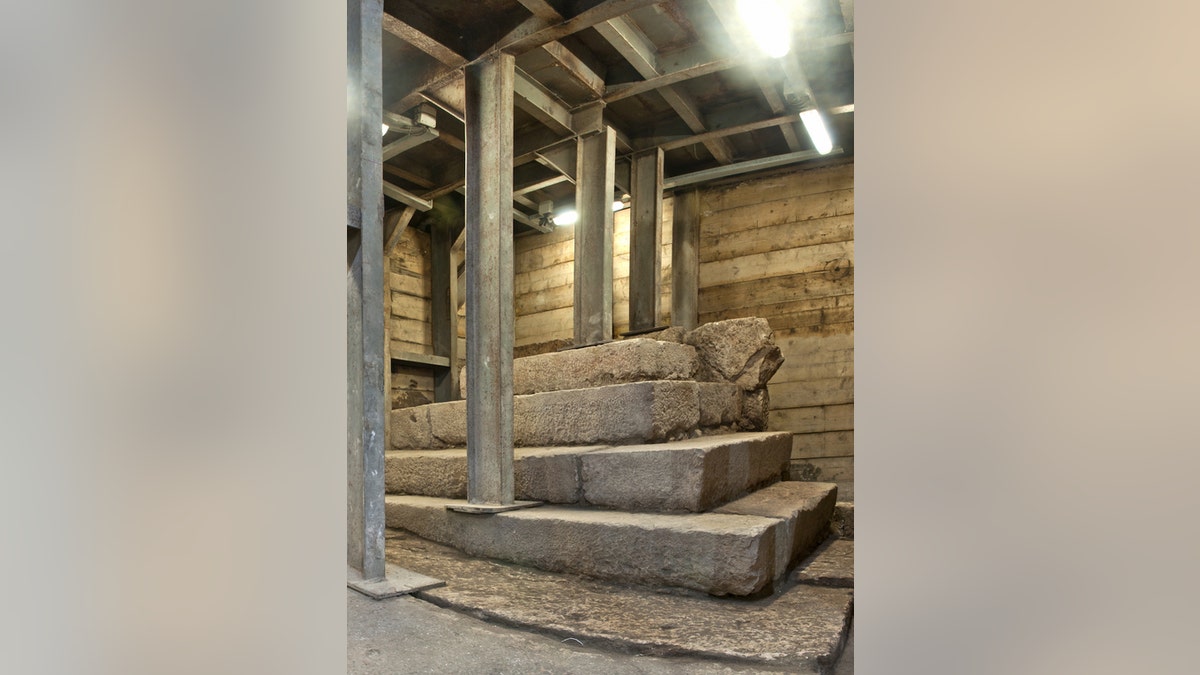
A mysterious podium used by itinerant street preachers or perhaps as a primitive lost-and-found has been unearthed in the ancient city of Jerusalem. The podium is nearly 2,000 years old. (Gil Mezuman courtesy of the Israel Antiquities Authority)
A mysterious podium has been uncovered in the ruins of ancient Jerusalem. The pyramidal structure, which has a small set of stairs made of finely cut rectangular stones, may have once been a public venue where street preachers spoke, or it may have been a public lost-and-found, researchers said.
The podium dates to the Second Temple Period, which ended in A.D. 70. The strange structure actually juts out into a 2,000-year-old walkway that led pilgrims up to the Temple Mount from the Pool of Siloam, an ancient ritual bath mentioned in both the Old and New Testaments.
"It's just its own stand-alone monument, with stairs in a pyramid shape leading up to this flat slab of stone, and so we started pondering what this could be for," said Joe Uziel, one of the lead excavators for the Israel Antiquities Authority. "We came to the realization that either something or someone must have stood on top of that last step in order to attract the attention of the pilgrims who would have walked by."
But exactly what those people were saying from the podium remains a mystery.
"Were messages announced here on behalf of the government? Perhaps news or gossip, or admonitions and street preaching — unfortunately, we do not know," Uziel and Nahshon Szanton, another archaeologist with the Israel Antiquities Authority who led the excavation, said in a statement. [The Holy Land: 7 Amazing Archaeological Finds]
The mysterious steps were first partially uncovered about a century ago, when archaeologists Frederick Bliss and Archibold Dickle were excavating ancient Jerusalem. But at that time, the archaeologists found only part of the ancient pilgrimage street and podium, and concluded that the stairway must have led to an old house that was destroyed.
The purpose of the podium is still unclear. However, the Mishnah and the Talmud — Jewish texts written after the Old Testament — mention a "stone of claims," a place where people who had lost items would go to find them. People with missing items would tell an announcer, who would then yell out to the crowd to see if anyone had found the items, Uziel said.
The street where the pyramidal structure was unearthed was a stepped walkway made of massive pavement stones.
"The street itself is quite monumental; it's about 7 meters [23 feet] wide," Uziel told Live Science. "A rough estimate is about 10,000 tons of stone were used to build the street."
Researchers found coins dating to A.D. 30 beneath the road, and the city of Jerusalem was razed in A.D. 70, suggesting the road was constructed between those two dates. A Roman ruler of Judea or Agrippas, the grandson of King Herod, may have built the long walkway, which was one of the most massive construction projects of its day, Uziel said.
Pilgrims would have traveled along the staircase at least three times a year, for the Jewish festivals such as Passover, Sukkot and Shavuot, which at that time, required ritual animal sacrifice, Uziel said. The pathway traveled along the Temple Mount along the Western Wall until it reached the Pool of Siloam. In the book of John, Jesus heals a blind man after telling him to bathe in the Pool of Siloam.
- In Photos: Amazing Ruins of the Ancient World
- Photos: 5,000-Year-Old Stone Monument in Israel
- Photos: A Walk Through Israel's Old Jaffa
Copyright 2015 LiveScience, a Purch company. All rights reserved. This material may not be published, broadcast, rewritten or redistributed.
